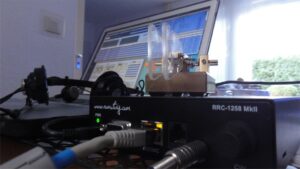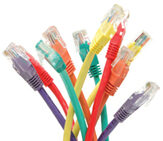In December 2006 I have visited TF4M Thor’s QTH and worked from his station for two weeks. This visit reminds me 70’s when I lived in Russian Far East Arctic area and worked with my call sign UA0KCE. It was long time ago, but amazing sounds of Arctic HF Bands has never been forgotten.
Icelandic HF is the same as UA0K or KL7 and you can’t feel any difference when the “Arctic Firewall” blocks all HF Bands. Same specific noise and no any signals or arctic flatter signals.
Thor TF4M build up himself a unique radio station in CQ Zone-40. The old style but very reliable and efficient rhombic antennas make his signals always booming on all HF Bands when propagation allows him to jump the “Arctic Firewall”.
During the station development Thor decided to setup an Remote Radio Control system and I promised to help him in beta test.
About one or two month later the RRC configuration has been finished and from July 4 I have tested his RRC in all technical details. But this operation was stopped on July 12, 2012 by anonymous complaints from two TF HAM’s. I was asked to stop my transnational remote-controlled operation while the legal aspects were investigated.
This situation made me and Thor to investigate the legal aspects of our operations so that it became clear that we did not violate any law.
 Control Box – RRC-1258mkII connected to MAC Book PRO / OS Snow Leopard / RUMlog / See Photos
Control Box – RRC-1258mkII connected to MAC Book PRO / OS Snow Leopard / RUMlog / See Photos
Some Legal aspects:
The operation is conducted in accordance with the rules as explained in the ARRL publication “Remote Operating for Amateur Radio”
Page 1-6, Chapter 1
”As far as the FCC is concerned, the Internet is just a very long cable. In this situation the FCC?s concern is limited to the issue of who controls the host station and how they identify themselves on the air. It doesn?t matter where the operator is located; he could be across the street or on the opposite side of the world”
Page 1-7, Chapter 1
”An American amateur can access and operate a foreign-based Internet remote control station if the host station is in a country that participates in the European Conference of Postal and Telecommunications Administrations (CEPT) or International Amateur Radio Permit programs. Again, the list is available at the Web site noted previously.
The American Amateur must use the call sign prefix of the country where the host station is located, followed by his call sign. For example, if the host station is in Austria, I would need to identify as OE/WB8IMY.”
Since the operator is located outside the host country, this operation does not give DXCC credit, as the ARRL says:
“If you want to play the game you have to know the rules” .
Paragraph 9 of the DXCC rules refers to remote operation:
“All stations must be contacted from the same DXCC entity. The location of any station shall be defined as the location of the transmitter. For the purposes of this award, remote operating points must be located in the same DXCC entity as the transmitter and receiver”.
I am holder of a US EXTRA CLASS license, is currently operating TF4M Thor’s Station remotely across the internet using the call sign TF/KL1A.
The operation also is conducted with the aim of fully testing the remote capability of Thor’s station, to experience Rhombics the Kings of Antennas, Arctic Propagation, and most of all to have fun.
The equipment used is the RRC-1258MkIIs by RemoteRig which works flawlessly and which basically extends the operation of Thor’s Elecraft K3 across the internet – very impressive.
From TF4M:
Getting things to work properly was challenging, since my internet connection is rather slow and the DSL router rather obsolete but the experiment is absolutely successful. I am unable to set these things up from within my own local area network.…
This opens up fantastic possibilities in the future for Icelandic Radio Amateurs who may have difficulty setting up a competitive station in the city, to operate from a large station in a RF quiet location.
Prior to this operation, Tord, SM3EVR tested the remote system with full success.
— — —
The TF/KL1A operation was conducted in good faith in accordance with instructions published in the book “Remote Operating for Amateur Radio” published by the ARRL.
excerpts from the book:
page 1-6, Chapter 1
“As far as the FCC is concerned, the Internet is just a very long cable. In this situation the
FCC?s concern is limited to the issue of who controls the host station and how they identify
themselves on the air. It doesn?t matter where the operator is located; he could be across the
street or on the opposite side of the world”page 1-7, Chapter 1
“An American amateur can access and operate a foreign-based Internet remote control
station if the host station is in a country that participates in the European Conference of
Postal and Telecommunications Administrations (CEPT) or International Amateur Radio
Permit programs. Again, the list is available at the Web site noted previously. The American
Amateur must use the call sign prefix of the country where the host station is located,
followed by his call sign. For example, if the host station is in Austria, I would need to
identify as OE/WB8IMY.”From the rear cover of the book:
“….This book also addresses the legal aspects of remote station control, as well as the unique issues of remote operating as it applies to activities such as DXing and contesting. With more than 100 pages of solid, practical advice, Remote Operating for Amateur Radio is your guide to getting back on the air with the station of your dreams – even if you live in an apartment!”
It was clearly understood that the operation was not valid for DXCC credit, since the operator was located outside the country of operation, such information was indeed published on KL1A?s QRZ.COM profile and on my own website.
Hans Blondeel Timmerman, PB2T President IARU, Region 1 was contacted by ?.R.A. to give his opinion on the matter. He replied that CEPT, T/R 61-01 was intended for individuals who wished to operate during short visits in a foreign country. Remote Operation was therefore never the intent of T/R 61-01.
Ulrich M?ller, DK4VW, Chairman, IARU Region 1 HF Committee, was also asked to give his opinion:
“Recommendation SC11_C4_07: That member societies bring to their members attention that the T/R 61-01 agreement only applies to people using their own call sign, with the appropriate country prefix, when the operator is actually visiting that country, not for remote operation.”
“Recommendation SC11_C4_08: That the Chairman of C4 is mandated to set up a sub-group to examine the question of transnational remote-controlled operation and to establish under what conditions such operation might, if ever, be regulated and to issue its findings in due course.”DK4VW mentioned that his plan is to raise this issue in a meeting on IARU Region 1 which will be held in Vienna, Austria next Spring.
David G. Sumner, K1ZZ was also contacted to give his opinion:
“thank you for bringing this to my attention. I was not aware that we had published
erroneous information. We will correct it.The following action of the IARU Region 1 Conference in Sun City last August reflects the actual situation:
Recommendation SC11_C4_07 (Paper SC11_C4_22): That member societies bring to their members attention that the T/R 61-01 agreement only applies to people using their own call sign, with the appropriate country prefix, when the operator is actually visiting that country, not for remote operation. Proposed by REF, seconded by EDR. Approved with four against.”
73,
David Sumner, K1ZZ
Chief Executive Officer, ARRLThe Icelandic Post & Telegraph Administration was contacted verbally by the ?.R.A. – their quick opinion was that CEPT regulations only applied to visitors physically present in the country.
?.R.A. has set up a committee to establish policy with regard to remote operations taking into account the international guidance which is being formulated. The committee members are: TF3DX, TF3KB and TF3Y.
My (TF4M’s) view:
From the above voiced opinions, it appears that transnational remote control is not specifically permitted by CEPT Regulations.
Recommendation SC11_C4_08 – quoted by DK4VW, clearly shows:
transnational remote operation is not regulated at present.
— — —
FYI: W4MQ Internet Remote Base (The Internet Remote Control Pioneer in HAM Radio) Recipient of the ARRL Technical Innovation Award.
— — —
Transnational Remote Operation : http://tf4m.com/transnational-remote-operation/
Related ARRL Publications:
August 2012 QST Magazine (pg 39-40) : Remote Radio Control Made Easy
ARRL Guide by WA8IMY : Remote Operating for Amateur Radio
Get on the Air from Anywhere! Remote Operating for Amateur Radio guides you through the process of establishing your own Internet-controlled station. You’ll learn the basics of how the Internet works, how home networks operate and how to interconnect Amateur Radio hardware and software for remote Internet control. You’ll find station diagrams, software tips and much more. This book also addresses the legal aspects of remote station control, as well as the unique issues of remote operating as it applies to activities such as DXing and contesting. With more than 100 pages of solid, practical advice, Remote Operating for Amateur Radio is your guide to getting back on the air with the station of your dreams – even if you live in an apartment!
Contents:
- The Case for Internet Remote Control
- Networks and the Need for Speed
- Bringing the Internet Home
- Hardware Integration
- The Audio Challenge
- The Listening Post
- Building a Complete Remote Station

